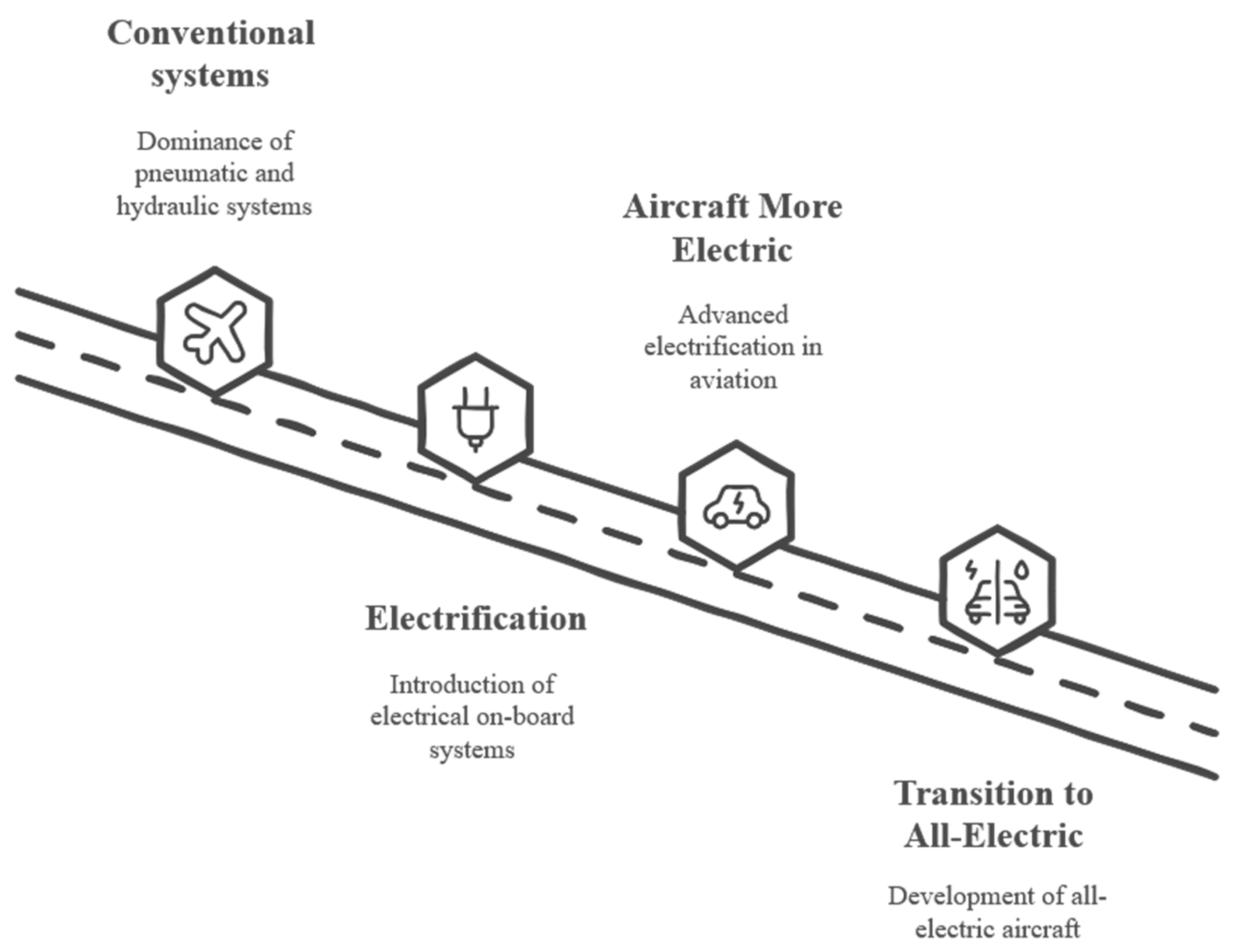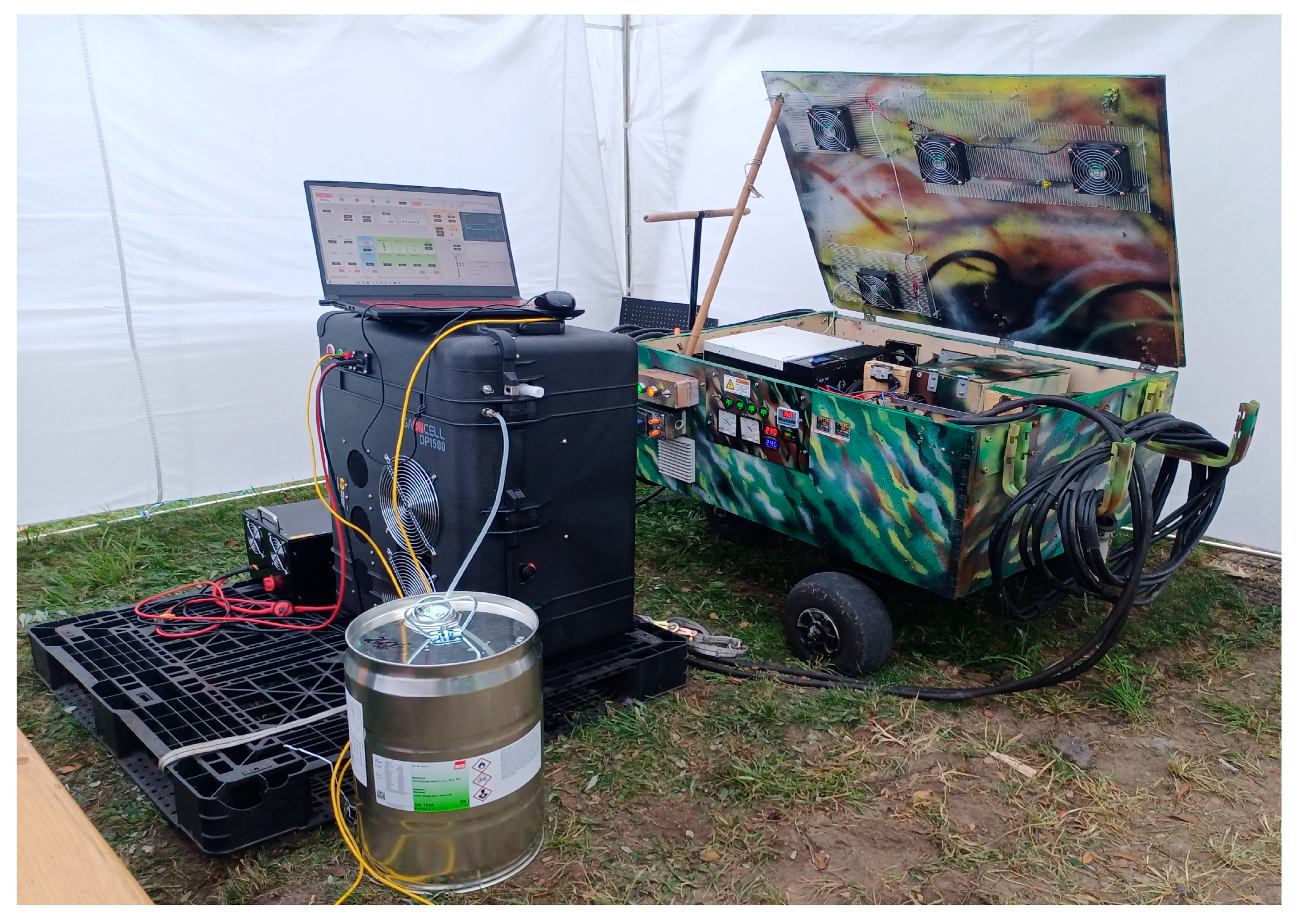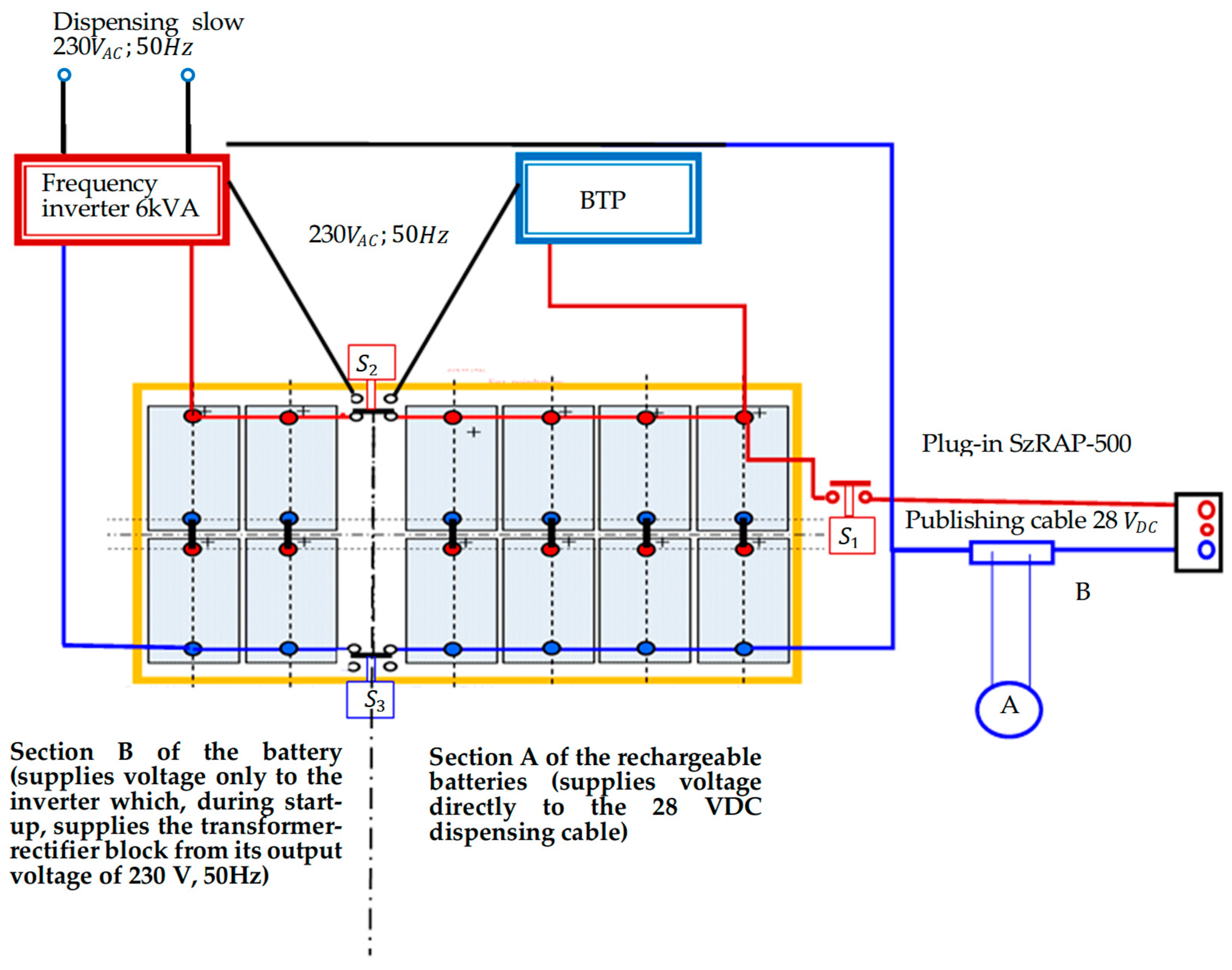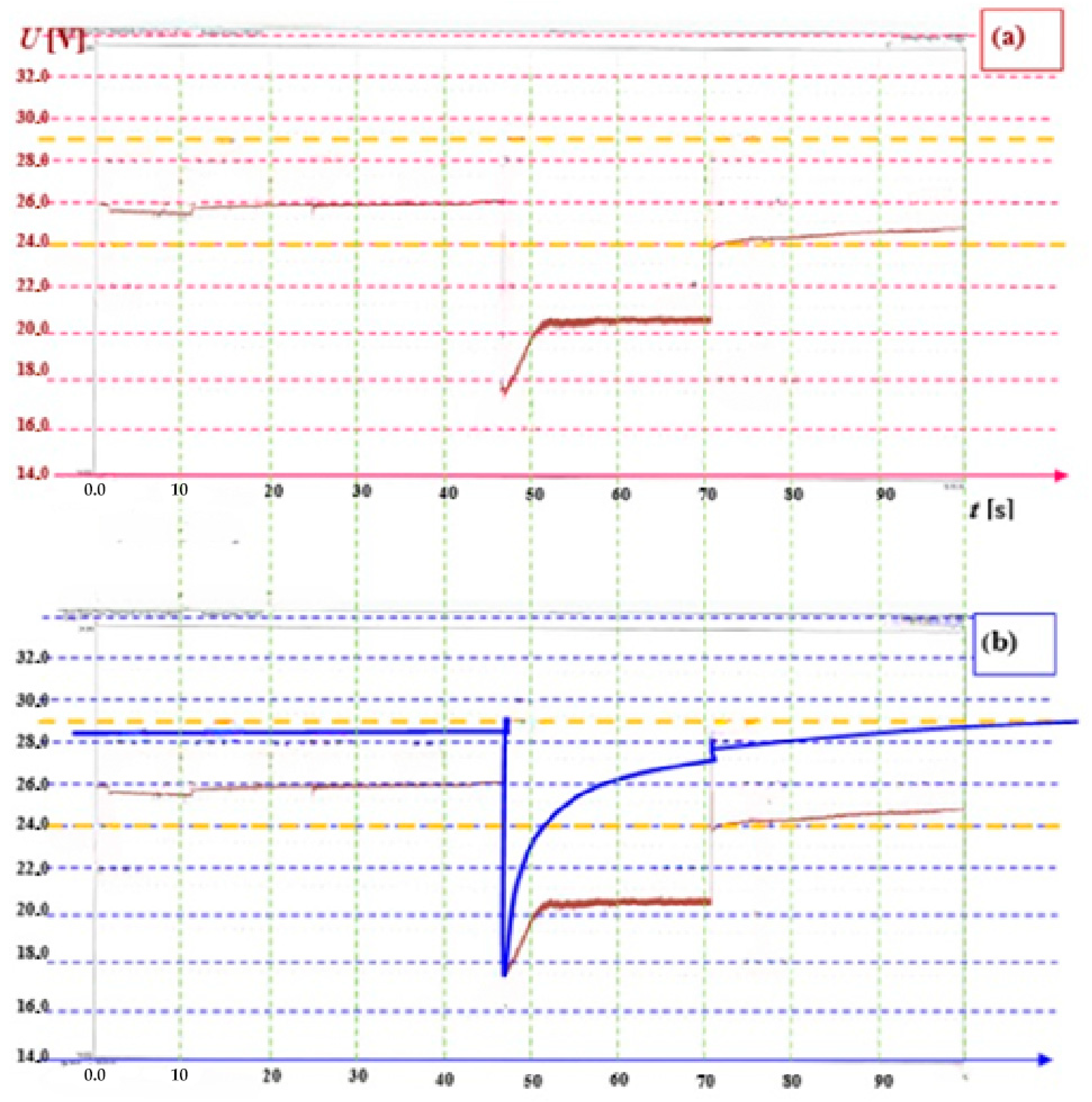Concepts and Experiments on More Electric Aircraft Power Systems
Abstract
:1. Introduction
1.1. Scope and Objectives of the Study
1.2. Challenges and Innovations in Aircraft Electrification
- Experimental assessment of a modular mobile power station (MPSZE) for aviation applications, validating its role in aircraft pre-flight diagnostics, auxiliary power, and emergency energy supply.
- Detailed frequency stability analysis, evaluating transient behavior and energy distribution in both conventional and hybrid-electric aircraft architectures.
- Optimization of hybrid power solutions by integrating high-capacity batteries, fuel cells, and photovoltaics to enhance system resilience and sustainability in real-world conditions.
1.3. Article Structure
- Section 2 provides a comprehensive literature review, covering the evolution of aircraft power systems, the transition to More Electric Aircraft (MEA), and the potential of alternative energy sources such as photovoltaics and fuel cells.
- Section 3 presents experimental analyses, including system stability assessments and the integration of renewable energy solutions in aviation applications.
- Section 4 discusses the implications of the findings, highlighting technological challenges and opportunities for the future of aircraft electrification.
- Section 5 concludes the study by summarizing key insights and proposing directions for future research.
2. Literature Review
2.1. Evolution of Aircraft Electrical Power Systems
- Main Generators (MGs) (Figure 2),
- Auxiliary Power Units (APUs), used during ground operations and as a backup power source,
- Ram Air Turbines (RATs), deployed in emergency situations.
2.2. Role of More Electric Aircraft in Modern Aviation
Examples of MEA Applications in Modern Aircraft
2.3. Assessment of Energy Demand in Modern Aircraft
2.3.1. Energy Requirements of Rotorcraft Platforms
2.3.2. Power Consumption in Systems and Ground Infrastructure
2.4. Alternative Energy Sources for Aviation
3. Materials and Methods
3.1. Research Methodology and Data Source
- Standard mode (without feedback stabilization)—to analyze voltage drops and transient fluctuations.
- Enhanced mode (with feedback stabilization)—to assess the role of the transformer–rectifier unit in stabilizing power output.
- Direct system measurements of frequency, voltage, and power stability recorded using precision monitoring equipment.
- Comparative frequency analysis, evaluating key frequency parameters such as nominal frequency, peak fluctuations, and long-term drift.
- Transient response analysis, comparing system behavior with and without feedback stabilization to highlight voltage stabilization effectiveness.
3.2. Experimental Setup of Photovoltaic-Assisted Aircraft Power Systems
- Ground operations—supplying auxiliary loads during maintenance, reducing dependency on external power sources.
- Emergency backup power—supporting critical electronic systems in case of generator failure.
- Hybrid energy storage systems—working in combination with lithium-ion batteries and supercapacitors to optimize energy efficiency.
- Energy storage optimization—improving battery–supercapacitor hybrid systems for enhanced stability.
- Advanced power management algorithms—intelligent energy flow control to regulate power fluctuations.
- Flexible photovoltaic panel integration—testing on various aircraft types to optimize efficiency in real-world conditions.
3.3. Fuel-Cell-Based Auxiliary Power Solutions for Aviation
- Pre-flight electrical system checks—powering avionics and diagnostic tools without starting the main engines.
- Emergency backup power—providing stable 230 V AC supply in case of on-board power failures.
- Ground operations support—enabling maintenance teams to conduct electrical system diagnostics with an independent power source.
- Fuel cell power unit (PEM technology)—supplying continuous power without CO2 emissions.
- Lithium-ion battery pack (48 V, 10 kWh)—acting as an energy buffer to stabilize transient loads.
- Inverter unit (6 kW, 230 V AC, 50 Hz)—converting stored energy to aircraft-compatible voltage.
- Integrated control module with an energy management system—optimizing fuel cell and battery operation based on demand.
3.4. Simulation and Validation of Modular Power Systems
- 1.
- Main “Passive” Section (Section A)
- 8 × 12 V lead–acid batteries (100 Ah each)
- Directly supplies the DC output cable
- 2.
- Auxiliary “Active” Section (Section B)
- 4 × 12 V lead–acid batteries (100 Ah each)
- Supports the AZO DIGITAL 6 kW-24 inverter
- Voltage stabilization—ensuring that transient fluctuations are reduced during high-load operations.
- Suppression of electromagnetic interference—preventing disturbances that could affect avionics and communication systems.
- B—Shunt ammeter
- A—Analog ammeter
- S1—Contactor activating voltage on the 28 VDC output cable, terminated with a SzRAP-500 plug
- Reducing voltage instability during transient loads by up to 30% compared to earlier versions.
- Minimizing EMI-related disturbances in avionics and communication systems.
- Enhancing battery longevity by optimizing energy distribution.
4. Results
4.1. Power Stability and Frequency Analysis
- Standard mode (MPSZE without feedback stabilization): The system powered the on-board electrical loads, and the engine start sequence, exposing transient voltage drops and fluctuations.
- Enhanced mode (MPSZE with feedback stabilization): The transformer–rectifier unit was engaged to provide additional voltage support and stabilize the DC power output during startup.
- Frequency drift rate (): Determines the rate at which the frequency deviates over time, affecting stability.
- RMS (Root Mean Square) frequency deviation: Quantifies the overall variation in frequency, which can impact sensitive avionics.
- Transient recovery time (): Measures how quickly the system stabilizes after a disturbance.
- High-resolution frequency analyzers were connected to the inverter output circuit.
- Data were collected at 100 ms intervals to detect short-term variations.
- Frequency drift measurements were conducted over a 10 min interval, capturing both transient and steady-state conditions.
- The system was tested under different electrical loads (baseline avionics vs. full engine startup).
- Mitigating voltage drops—transient fluctuations reduced by up to 30% in enhanced mode.
- Ensuring reliable power delivery—frequency deviations were stabilized to within ±0.02 Hz, minimizing potential interference with on-board systems.
- Reducing frequency drift effects—long-term drift was kept below 0.008 Hz/min, ensuring continuous operational stability.
4.2. Experimental Evaluation of the MPSZE System
- High-resolution frequency analyzers were used to record real-time frequency variations at 100 ms intervals.
- Continuous frequency data were collected over multiple operational cycles, including startup and transient conditions.
- The frequency drift rate was observed over a 10 min period to assess long-term behavior.
- Load variations between 5% and 85% were applied to observe the impact on frequency stability.
- The short-term frequency variation does not exceed 0.021%, minimizing its impact on avionics.
- Long-term drift remains below 0.008 Hz/min, ensuring power stability over extended operational periods.
- Feedback-controlled rectification effectively regulates frequency variations, reducing transient voltage drops by up to 30%.
4.3. Impact of Feedback Stabilization on Power Distribution
Transient Response of MPSZE During Helicopter Startup
- (a)
- response without feedback stabilization—MPSZE
- (b)
- response with feedback stabilization—MPSZE
- Voltage Stability and Risk of Overcharging: The active feedback loop effectively reduced the duration of voltage drops below 24 V, ensuring more stable power delivery during startup. However, once the current demand subsided, the system intensively recharged Section B (8 lead–acid batteries), increasing the risk of overcharging and excessive depletion of Section A (4 lead–acid batteries supporting the photovoltaic inverter). To prevent this, it is recommended to disable the feedback loop when current demand falls below 3290 A.
- Suppression of Oscillations: The multiple oscillations observed during sudden load reductions were significantly dampened. The number of oscillations decreased to one, and their amplitude was reduced, improving system response stability.
- Improved Frequency Stability: The active feedback mechanism reduced frequency drift in conditions of dynamic DC load variations, contributing to a more stable power supply for on-board systems.
5. Discussion
5.1. Key Findings and Interpretation in the Context of Prior Research
5.2. Implications of Advanced Power Systems for Future Aircraft Design
- Reducing fuel consumption by minimizing dependence on combustion-driven APUs.
- Enhancing system redundancy and reliability, ensuring uninterrupted power supply to critical aircraft systems.
- Integrating energy storage with high-voltage electrical architectures in future hybrid-electric propulsion systems.
- Supporting distributed power generation, where on-board energy storage complements fuel-cell or solar-based energy systems for extended operational endurance.
5.3. Challenges in Integrating Renewable Energy into Aviation
- Energy density limitations: Current battery and solar technologies have low power-to-weight ratios, making them impractical for high-energy-demand aircraft systems.
- Intermittency of renewable sources: Solar energy generation fluctuates based on weather conditions and operational altitude, requiring hybridized storage solutions for consistent power output.
- Power management complexity: The need for adaptive switching, real-time load balancing, and voltage stabilization increases system complexity and integration challenges.
- Thermal management issues: High-power energy storage solutions, including lithium-ion batteries and fuel cells, require advanced cooling solutions to prevent overheating and efficiency losses.
5.4. Potential Applications of Mobile Energy Storage Systems
- (a)
- Aircraft Ground Operations and Maintenance
- Providing auxiliary power during aircraft servicing to reduce fuel dependency and support sustainable airport operations.
- Acting as an emergency backup system in cases of unexpected APU failure or ground power unit (GPU) unavailability.
- (b)
- Unmanned Aerial Vehicles (UAVs) and Remote Sensing Platforms
- Powering UAVs and electric propulsion systems in extended operations.
- Supporting modular battery swapping systems to improve UAV endurance and operational efficiency.
- (c)
- Emergency Power Supply
- Supplying field-deployed radar, surveillance, and communication systems with reliable off-grid power.
- Enhancing mobile command centers and field hospitals with renewable-powered energy storage solutions.
5.5. Limitations of the Study and Future Research Directions
- Experimental conditions were limited to ground-based testing under controlled scenarios. Further in-flight evaluations are required to assess system performance in real-world operating conditions.
- The study focused on lead–acid battery configurations, which, while reliable, are less efficient compared to lithium-ion or solid-state battery technologies. Future research should explore alternative energy storage solutions for improved energy density and weight reduction.
- The feedback stabilization mechanism effectively mitigated transient instability; however, it introduced potential risks of overcharging under low-current conditions. Further refinement of adaptive energy regulation algorithms is necessary to prevent long-term battery degradation.
- The role of hybrid energy integration (solar, battery, and fuel cell combinations) was not fully explored in this study. Future work should investigate multi-source energy architectures, optimizing power allocation between different energy storage and generation methods.
6. Conclusions
Author Contributions
Funding
Data Availability Statement
Conflicts of Interest
References
- Harikumaran, J.; Buticchi, G.; Galea, M.; Costabeber, A.; Wheeler, P. Reliability Analysis of Aircraft Starter Generator Drive Converter. In Proceedings of the 2019 IEEE 15th Brazilian Power Electronics Conference and 5th IEEE Southern Power Electronics Conference (COBEP/SPEC), Santos, Brazil, 1–4 December 2019; IEEE: New York, NY, USA, 2019. [Google Scholar]
- Madonna, V.; Giangrande, P.; Galea, M. Electrical Power Generation in Aircraft: Review, Challenges, and Opportunities. IEEE Trans. Transp. Electrif. 2018, 4, 646–659. [Google Scholar] [CrossRef]
- Ni, K.; Liu, Y.; Mei, Z.; Wu, T.; Hu, Y.; Wen, H.; Wang, Y. Electrical and Electronic Technologies in More-Electric Aircraft: A Review. IEEE Access 2019, 7, 76145–76166. [Google Scholar] [CrossRef]
- Zeng, Y.; Jiang, S.; Konstantinou, G.; Pou, J.; Zou, G.; Zhang, X. Multi-Objective Controller Design for Grid-Following Converters with Easy Transfer Reinforcement Learning. IEEE Trans. Power Electron. 2025, 40, 6566–6577. [Google Scholar] [CrossRef]
- Schettini, F.; Denti, E.; Di Rito, G. Development of a simulation platform of all-electric aircraft on-board systems for energy management studies. Aeronaut. J. 2017, 121, 710–719. [Google Scholar] [CrossRef]
- Arabul, A.Y.; Kurt, E.; Arabul, F.K.; Şenol, I.; Schrötter, M.; Bréda, R.; Megyesi, D. Perspectives and Development of Electrical Systems in More Electric Aircraft. Int. J. Aerosp. Eng. 2021, 2021, 5519842. [Google Scholar] [CrossRef]
- Sarlioglu, B.; Morris, C.T. More Electric Aircraft: Review, Challenges, and Opportunities for Commercial Transport Aircraft. IEEE Trans. Transp. Electrif. 2015, 1, 54–64. [Google Scholar] [CrossRef]
- Hernandez, D.; Sautreuil, M.; Retiere, N.; Riu, D.; Sename, O. A new methodology for aircraft HVDC power systems design. In Proceedings of the 2009 IEEE International Conference on Industrial Technology—(ICIT), Churchill, Australia, 10–13 February 2009; pp. 1–6. [Google Scholar] [CrossRef]
- Harikumaran, J.; Buticchi, G.; Migliazza, G.; Wheeler, P.; Galea, M. Reliability oriented thermal management of aircraft power converters. In Proceedings of the 2020 IEEE 9th International Power Electronics and Motion Control Conference (IPEMC2020-ECCE Asia), Nanjing, China, 29 November–2 December 2020; pp. 1590–1594. [Google Scholar] [CrossRef]
- Valente, G.; Sumsurooah, S.; Hill, C.I.; Rashed, M.; Vakil, G.; Bozhko, S.; Gerada, C. Design Methodology and Parametric Design Study of the On-Board Electrical Power System for Hybrid Electric Aircraft Propulsion. IET Conf. Proc. 2021, 2020, 448–454. [Google Scholar] [CrossRef]
- Fioriti, M.; Mirzoyan, A.; Isianov, A. Applying a distributed collaborative MDAO environment to study the power matching of the propulsion system and the on-board electrified systems for advanced regional and short- to medium-range jetliners. Aeronaut. J. 2019, 123, 1618–1638. [Google Scholar] [CrossRef]
- Zieja, M.; Gębura, A.; Szelmanowski, A.; Główczyk, B. Non-Invasive Monitoring of the Technical Condition of Power Units Using the FAM-C and FDM-A Electrical Methods. Sustainability 2021, 13, 13329. [Google Scholar] [CrossRef]
- Basora, L.; Olivé, X.; Dubot, T. Recent Advances in Anomaly Detection Methods Applied to Aviation. Aerospace 2019, 6, 117. [Google Scholar] [CrossRef]
- Hao, Z.; Wang, X.; Cao, X. Harmonic Control for Variable-Frequency Aviation Power System Based on Three-Level NPC Converter. IEEE Access 2020, 8, 132775–132785. [Google Scholar] [CrossRef]
- Setlak, L.; Kowalik, R. Mathematical modeling and simulation of selected components on-board autonomous power supply system (ASE), in accordance with the concept of a more electric aircraft (MEA). In Proceedings of the 2017 18th International Scientific Conference on Electric Power Engineering (EPE), Kouty nad Desnou, Czech Republic, 17–19 May 2017; pp. 1–6. [Google Scholar] [CrossRef]
- Wang, Z.; Jiang, D.; Liu, Z.; Zhao, X.; Yang, G.; Liu, H. A Review of EMI Research of High Power Density Motor Drive Systems for Electric Actuator. Actuators 2023, 12, 411. [Google Scholar] [CrossRef]
- Buticchi, G.; Wheeler, P.; Boroyevich, D. The More-Electric Aircraft and Beyond. Proc. IEEE 2022, 111, 356–370. [Google Scholar] [CrossRef]
- Voth, V.; Lübbe, S.M.; Bertram, O. Estimating Aircraft Power Requirements: A Study of Electrical Power Demand Across Various Aircraft Models and Flight Phases. Aerospace 2024, 11, 958. [Google Scholar] [CrossRef]
- Feng, C.; Hu, M.-H.; Zhao, Z. A New Optimization Model of Airport Gate Assignment. J. Transp. Syst. Eng. Inf. Technol. 2012, 12, 131–138. [Google Scholar]
- Fuglestvedt, J.; Lund, M.T.; Kallbekken, S.; Samset, B.H.; Lee, D.S. A “greenhouse gas balance” for aviation in line with the Paris Agreement. WIREs Clim. Change 2023, 14, e839. [Google Scholar] [CrossRef]
- Bendarkar, M.V.; Rajaram, D.; Cai, Y.; Mavris, D.N. Optimal Paths for Progressive Aircraft Subsystem Electrification in Early Design. J. Aircr. 2021, 59, 219–232. [Google Scholar] [CrossRef]
- Ybanez, L.; Colle, A.; Nilsson, E.; Berg, F.; Galla, G.; Tassisto, M.; Rivenc, J.; Kapaun, F.; Steiner, G. ASCEND: The first step towards cryogenic electric propulsion. IOP Conf. Ser. Mater. Sci. Eng. 2022, 1241, 012034. [Google Scholar] [CrossRef]
- Goyal, R.; Cohen, A. Advanced Air Mobility: Opportunities and Challenges Deploying eVTOLs for Air Ambulance Service. Appl. Sci. 2022, 12, 1183. [Google Scholar] [CrossRef]
- Mihara, Y.; Pawnlada, P.; Nakamoto, A.; Nakamura, T.; Nakano, M. Cost Analysis of eVTOL Configuration Design for an Air Ambulances System in Japan. In Proceedings of the CESUN 2020 Engineering Systems Symposium, West Lafayette, IN, USA, 9–11 June 2020. [Google Scholar] [CrossRef]
- Małachowski, J.; Żurek, J.; Ziółkowski, J.; Lęgas, A. Application of the Transport Problem from the Criterion of Time to Optimize Supply Network with Products “Fast-Running”. J. Konbin 2019, 49, 127–137. [Google Scholar] [CrossRef]
- Cañete, A.; Djemame, K.; Amor, M.; Fuentes, L.; Aljulayfi, A. A proactive energy-aware auto-scaling solution for edge-based infrastructures. In Proceedings of the 2022 IEEE/ACM 15th International Conference on Utility and Cloud Computing (UCC), Vancouver, WA, USA, 6–9 December 2022; pp. 240–247. [Google Scholar] [CrossRef]
- Trainelli, L.; Salucci, F.; Riboldi, C.E.D.; Rolando, A.; Bigoni, F. Optimal Sizing and Operation of Airport Infrastructures in Support of Electric-Powered Aviation. Aerospace 2021, 8, 40. [Google Scholar] [CrossRef]
- Goh, C.S.; Kuan, J.R.; Yeo, J.H.; Teo, B.S.; Danner, A.J. A fully solar-powered quadcopter able to achieve controlled flight out of the ground effect. Prog. Photovolt. Res. Appl. 2019, 27, 869–878. [Google Scholar] [CrossRef]
- Hertwich, E.G.; Gibon, T.; Bouman, E.A.; Arvesen, A.; Suh, S.; Heath, G.A.; Bergesen, J.D.; Ramirez, A.; Vega, M.I.; Shi, L. Integrated life-cycle assessment of electricity-supply scenarios confirms global environmental benefit of low-carbon technologies. Proc. Natl. Acad. Sci. USA 2015, 112, 6277–6282. [Google Scholar] [CrossRef]
- Löhr, L.; Houben, R.; Guntermann, C.; Moser, A. Nested Decomposition Approach for Dispatch Optimization of Large-Scale, Integrated Electricity, Methane and Hydrogen Infrastructures. Energies 2022, 15, 2716. [Google Scholar] [CrossRef]
- Omoniwa, B.; Galkin, B.; Dusparic, I. Energy-aware optimization of UAV base stations placement via decentralized multi-agent Q-learning. In Proceedings of the 2022 IEEE 19th Annual Consumer Communications & Networking Conference (CCNC), Las Vegas, NV, USA, 8–11 January 2022; pp. 216–222. [Google Scholar] [CrossRef]
- Unger, N. Global climate impact of civil aviation for standard and desulfurized jet fuel. Geophys. Res. Lett. 2011, 38, L20803. [Google Scholar] [CrossRef]
- Zhou, J.; Yi, Q.; Wang, Y.; Ye, Z. Temperature distribution of photovoltaic module based on finite element simulation. Sol. Energy 2015, 111, 97–103. [Google Scholar] [CrossRef]
- Dinesh, H.; Pearce, J.M. The potential of agrivoltaic systems. Renew. Sustain. Energy Rev. 2016, 54, 299–308. [Google Scholar] [CrossRef]
- Mungkin, M.; Satria, H.; Maizana, D.; Isa, M.; Syafii, S.; Puriza, M.Y. Analysis of the feasibility of adding a grid-connected hybrid photovoltaic system to reduce electrical load. Int. J. Power Electron. Drive Syst. (IJPEDS) 2023, 14, 1160–1171. [Google Scholar] [CrossRef]
- Li, B.; Chen, X.; Jain, A. Power modeling of degraded PV systems: Case studies using a dynamically updated physical model (PV-Pro). Renew. Energy 2024, 236, 121493. [Google Scholar] [CrossRef]
- Bakar, A.; Ke, L.; Liu, H.; Xu, Z.; Wen, D. Design of Low Altitude Long Endurance Solar-Powered UAV Using Genetic Algorithm. Aerospace 2021, 8, 228. [Google Scholar] [CrossRef]
- Setlak, L.; Kowalik, R.; Gębura, A.; Gołda, P. Dynamic stability analysis of the aircraft electrical power system in the more electric aircraft concept. Sci. Rep. 2024, 14, 25521. [Google Scholar] [CrossRef]









| Lp. | Parameter | Unit | Value |
|---|---|---|---|
| 1 | 2 | 3 | 4 |
| 1 | fsr | Hz | 49.997 ± 0.012 |
| 2 | Fmax | Hz | 50.154 ±0.001 |
| 3 | % | 100.31 ± 0.02 | |
| 4 | Fmin | Hz | 49.41 ± 0.47 |
| 5 | % | 98.83 ± 0.01 | |
| 6 | fpp | Hz | 0.41 ± 0.16 |
| 7 | fp | Hz | 0.0083 ± 0.0012 |
| 8 | % | 0.021 ± 0.001 | |
| 9 | ΔF | Hz | 0.25 ± 0.12 |
| 10 | % | 0.511 ± 0.002 | |
| 11 | drift | Hz/min | 0.0075 ± 0.0131 |
Disclaimer/Publisher’s Note: The statements, opinions and data contained in all publications are solely those of the individual author(s) and contributor(s) and not of MDPI and/or the editor(s). MDPI and/or the editor(s) disclaim responsibility for any injury to people or property resulting from any ideas, methods, instructions or products referred to in the content. |
© 2025 by the authors. Licensee MDPI, Basel, Switzerland. This article is an open access article distributed under the terms and conditions of the Creative Commons Attribution (CC BY) license (https://creativecommons.org/licenses/by/4.0/).
Share and Cite
Gębura, A.; Szelmanowski, A.; Jacyna-Gołda, I.; Gołda, P.; Kalbarczyk, M.; Tomaszewska, J. Concepts and Experiments on More Electric Aircraft Power Systems. Energies 2025, 18, 1653. https://doi.org/10.3390/en18071653
Gębura A, Szelmanowski A, Jacyna-Gołda I, Gołda P, Kalbarczyk M, Tomaszewska J. Concepts and Experiments on More Electric Aircraft Power Systems. Energies. 2025; 18(7):1653. https://doi.org/10.3390/en18071653
Chicago/Turabian StyleGębura, Andrzej, Andrzej Szelmanowski, Ilona Jacyna-Gołda, Paweł Gołda, Magdalena Kalbarczyk, and Justyna Tomaszewska. 2025. "Concepts and Experiments on More Electric Aircraft Power Systems" Energies 18, no. 7: 1653. https://doi.org/10.3390/en18071653
APA StyleGębura, A., Szelmanowski, A., Jacyna-Gołda, I., Gołda, P., Kalbarczyk, M., & Tomaszewska, J. (2025). Concepts and Experiments on More Electric Aircraft Power Systems. Energies, 18(7), 1653. https://doi.org/10.3390/en18071653






